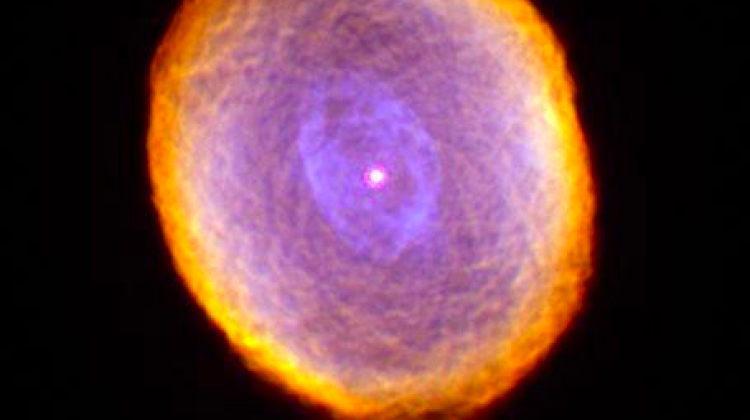A colourful nebula will shine around the aging Sun
 Photo: NASA and The Hubble Heritage Team (STScI/AURA)
Photo: NASA and The Hubble Heritage Team (STScI/AURA)
In a few billion years, the Sun will spread its outer layers around it and illuminate them, creating a colourful planetary nebula. Astronomers, including a Polish researcher, investigated the evolution of nebulae and shed new light on the aging of stars.
Planetary nebulae can be really beautiful in the night sky. They look like giant, colourful clouds suspended in space. They are so photogenic that they end up on the covers of numerous astronomy books and are given names that feed our imagination: Spirograph, Cat`s Eye, Little Ghost, Eskimo, White-Eyed Pea, Red Spider, Helix...
OLD STAR PUTS ON A STRIPTEASE SHOW
Planetary nebulae can form at the end of life of medium-sized stars. The star then spreads its outer layers around itself and loses as much as 50-80 percent of its mass. Only the extremely hot nucleus remains in the centre. At that time it only emits UV rays, invisible to the naked eye. When this radiation reaches the scattered shell, it ionizes the gas, and the nebula - the gigantic cloud around the star - begins to glow with visible light. "Hydrogen glows red, and doubly ionized oxygen - yellow-green. That is why the nebulae are so beautiful and easy to observe" - explains Prof. Krzysztof Gęsicki from the Nicolaus Copernicus University in Toruń.
Prof. Gęsicki together with colleagues from Argentina and the UK looked at new models of nebula evolution and compared theory with observations. "We can confirm that the new models, at which some looked with suspicion, are accurate" - sums up the scientist. The study, of which Prof. Gęsicki is the first author, appeared in "Nature Astronomy".
SHEDDING NEW LIGHT ON THE OLD SUN
Earlier models showed that although the Sun will create a planetary nebula in the future, this nebula will not be luminous. It seemed that our star is too small and after scattering the outer layers, the nebular gas will escape before it can be ionised and glow. Meanwhile, new, more spectacular solar old age emerges from new models.
"The new models suggest that the Sun - even if barely - will still be able to light up the planetary nebula. A star only a few percent smaller than the Sun would not be capable of doing it. Gas would escape and the nebula would be dark" - says the astronomer from the Nicolaus Copernicus University.
The new models show that stars live intensively in the later stages - they reach high temperatures 3-4 times faster than expected. And such faster heating up will allow to light up the nebula in time.
BRIGHT ONLY TO A DEGREE
Scientists also wondered for a long time why nebulae reach a certain limit of brightness. "This limit is the same for old and young stars, for massive and less massive ones" - says the scientist. Older models did not explain the reasons for this limit. "And newer models, which we have confirmed, explain this" - comments the researcher.
BILLIONS OF YEARS WITHOUT SECRETS
Prof. Gęsicki explains what his research was about. "Everyone thinks that an astronomer is someone who stares at the sky and counts the stars. In our case it`s actually true. We do just that - we count the stars, in this particular case the planetary nebulae, but we do it in a special way. We check how many of them are brightest, how many are less bright, and how many even weaker etc." - he says.
These calculations allow to create graphs. On their basis, researchers can create and verify models that explain what is happening with the brightness of the star at various stages of its evolution. "This allows to learn what happens to the stars over billions of years, even though as humans we have only conducted research only for several dozen, maybe a few hundred years" - adds the astronomer.
Although the flare of the planetary nebula around the Sun will be an amazing phenomenon, the inhabitants of Earth will not see it. Earlier, in about 4.5 billion years, the Sun will turn into a red giant and - as researchers believe - it will consume our planet. The formation of the nebula will take place afterwards. The nebula will survive for about 10,000 years and then dissipate, and later that the Sun will end its life cooling down over billions of years as a white dwarf.
PAP - Science in Poland
Author: Ludwika Tomala
lt/ agt/ kap/
tr. RL
Przed dodaniem komentarza prosimy o zapoznanie z Regulaminem forum serwisu Nauka w Polsce.















